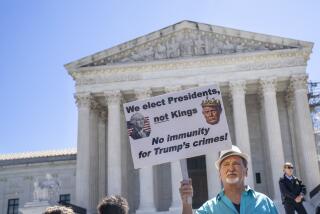Suing over crosses on government land
Today’s topic: What’s the central focus of Salazar vs. Buono -- who has standing to sue over violations of the 1st Amendment’s establishment clause, or, more broadly, whether any religious display on publicly owned land is constitutional?
The U.S. Supreme Court will hear oral arguments in Salazar vs. Buono on Oct. 7. The case involves a war memorial cross erected in the Mojave National Preserve; click here for a backgrounder from the Pew Research Center.
Point: Joseph Infranco, Alliance Defense Fund senior counsel
The Supreme Court will likely focus on two issues: first, whether the plaintiff had standing -- or the right to initiate an action against a veterans memorial in the shape of a cross; and second, whether a “land swap” approved by Congress (returning the property to a veterans group) cured an alleged establishment clause problem.
I will focus primarily on the first question today. The subject of “standing” sounds very technical, and therefore masks a concept many readers will find surprising. Traditionally, a person suing needs to prove some sort of real and concrete harm. Frank Buono, who first brought this case to the courts, sued under a narrow exception (which courts still struggle to define) because something offends him. This gentleman, who no longer resides in California, claims that he drives through the Mojave National Preserve a few times a year and that the mere sight of a small, cross-shaped veterans memorial causes him deep offense. Although there is another access point to the preserve that would protect Buono from this “abhorrent” sight, changing his route is inconvenient for Buono -- and so the offense remains.
Further, Buono (with the ACLU’s help) claims that this small memorial, located literally in the middle of a desert, is also a religious symbol -- and therefore amounts to something like a government establishment of Christianity. Not surprisingly, the largest veterans organizations in the country, the American Legion and the Veterans of Foreign Wars, together speaking for about 5 million veterans, have filed briefs calling the suit an outrage. Putting aside for the moment whether a religious symbol is or should be permitted on government land, the veterans view the cross as a symbol of courage, sacrifice and valor. A retired general and recipient of our nation’s second-highest military award, the Distinguished Service Cross, once asked me whether the ACLU intended to sue over the medal’s shape. I sometimes wonder.
When visitors to the hallowed grounds of the military cemeteries near Normandy Beach view rows of crosses and some headstones adorned with a Star of David, they do not see an endorsement of any faith. When motorists pass a small cross with flowers on the side of a road, they tend to think it is a memorial to someone who died there. Only people with eggshell-thin sensitivities think otherwise -- and we should not allow their hypersensitivity to wipe away centuries of American tradition. Oh, and by the way, the Alliance Defense Fund is defending against such a lawsuit in Utah, where an offended observer wants to remove roadside crosses memorializing state troopers slain in the line of duty. The state troopers are furious over that one.
We are all offended by some of the things we see. We get upset about how others think or act all the time. In a landmark 1971 U.S. Supreme Court decision, a man walked around wearing a jacket that read “F--- the Draft.” This, frankly, offends me. I would not want young children exposed to its crude vulgarity. Yet, the Supreme Court said I should buck up and remember “one man’s vulgarity is another’s lyric.” I’d give good odds, Professor Chemerinsky, that you agree with this decision and would say offense is a small price to pay for robust speech rights. Yet, in another context, someone’s offense is so important that millions of veterans must be slapped down in their effort to honor those who died in wars. It is a staggering -- even bizarre -- double standard.
Sacramento Bee columnist Margaret A. Bengs said it best when she wrote on Monday, “No one can possibly believe that a cross on a war memorial in the desert that happens to be on federal land means that the government has decreed Christianity the official religion of the United States -- the ludicrous claim of the ACLU.” Millions of veterans might add a hearty amen -- and I doubt they would care if it offends this plaintiff.
Counterpoint: Erwin Chemerinsky, UC Irvine School of Law dean
For decades the Supreme Court has limited the ability of the government to place religious symbols on government property. The court has held that the 1st Amendment’s prohibition of laws respecting the establishment of religion is violated if the reasonable observer would perceive the symbol as endorsing a faith. The court has applied this test to nativity scenes, Ten Commandments monuments, menorahs, crosses and other religious symbols.
My sense is that the real disagreement between you and I, Joe, is over whether the establishment clause of the 1st Amendment should limit religious symbols on government property. From the tone of your post, I gather that you would impose no limits on the government’s ability to place religious symbols on publicly owned property.
I, on the other hand, believe that government should be secular, that the place for religion is in people’s lives, homes and places of worship. A person has a right to put a religious symbol on his or her lawn, and churches and synagogues certainly can display them. But they don’t belong on government property.
If, as I suspect, this is the real disagreement between you and me, then the argument is only incidentally about standing or about whether this cross will be perceived as a religious symbol or a veterans memorial. You, I surmise, see no problem at all with a cross on government property even if it is clearly and unquestionably a religious symbol.
In your post, Joe, you confuse two distinct questions: who has standing to sue to challenge a religious monument on government property, and whether the display being challenged violates the establishment clause. Both of these questions are presented in this case, though the court only will reach the latter question if it finds that Buono has standing to sue.
The Supreme Court has consistently allowed lawsuits by those who encounter a religious symbol that they believe violates the 1st Amendment. Four years ago, I represented in the Supreme Court a homeless man, Thomas Van Orden, who challenged a six-foot-high, three-foot-wide Ten Commandments monument that sits between the Texas Capitol and the state Supreme Court. Not one brief objected to Van Orden’s standing; not one justice asked about it at oral argument.
There is no doubt that Buono regularly encounters this religious symbol and thus his standing is the same as all of the prior plaintiffs who brought similar suits. Indeed, when Buono brought this lawsuit, the government did not challenge his standing either at trial or on appeal. Only after Buono prevailed and sought to enforce the injunction he received was there a challenge to his standing. But his standing was established by the final ruling in the earlier proceedings.
The law is exactly as it should be with regard to standing. If religious symbols on government property can violate the establishment clause, as current law holds, then individuals exposed to such symbols must be able to sue. Otherwise, the limits imposed by the establishment clause are rendered meaningless.
More to Read
A cure for the common opinion
Get thought-provoking perspectives with our weekly newsletter.
You may occasionally receive promotional content from the Los Angeles Times.










